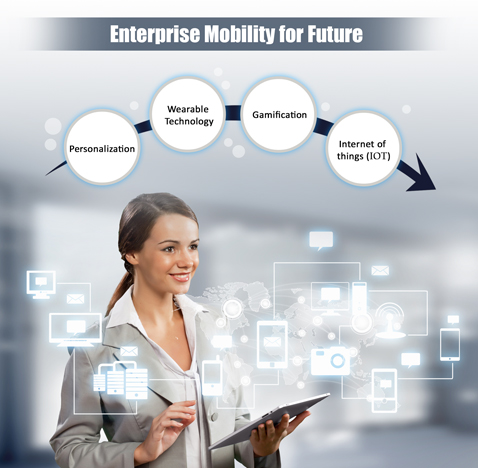
Technical Architect – Advanced Technologies Group
Blue Star Infotech,
Mobile Technologies have witnessed exponential growth in the past decade. This paradigm shift from desktop computing to mobile technology will unearth a lot of innovations in days to come. And the time is not far when mobile technology will allow identification of user much more efficiently, writes Sagar Mody, Technical Architect – Advanced Technologies Group, Blue Star Infotech, which offers specialised IT services in the space of mobility, cloud computing, and analytics and business intelligence across seven industry verticals.
Mobile Technologies have witnessed exponential growth in the past decade owing to factors such as integration of mobile devices with their various applications and software and performing business intelligence functions. The affordances of mobile technologies for enterprises have increased in both in-premises as well as on-field context. This still seems like the tip of an iceberg.
This paradigm shift from desktop computing to mobile technology would surely unearth a lot of innovations in days to come. The future of mobility is a broad subject and in this context it is vital to talk about things that are relevant to Enterprise. Although most of this has been discovered already, much of these innovations will be implemented as mass adoptions and change the way an organisation operates.
Catering to individual needs through implementation of BI: Currently, various applications track user activities, from physical steps they take to transactions they perform in enterprise applications. Soon enterprise would leverage this data to build Business Intelligence (BI) and apply Prediction algorithms to forecast various avenues, provide better and more personalised recommendation, show actionable statistics and analytics and more.
Sensors enable capturing micro-data and correlation between such data-capture would enable context aware application that could push timely and relevant information to the user.
Gamification of mundane enterprise tasks: Adding entertainment to routine activities has proved to be a successful way to motivate people, and smartphones are well equipped to assist. Mobility would facilitate automatic tracking of progress, offer creative ways to execute goals and enable real-time collaboration to accomplice various tasks faster.
IoT to deliver significant business benefits: Ubiquitous Internet connectivity and availability of smart devices enables organizations with howling opportunity to built innovative products and services, drive down operational costs and create additional revenue streams. The Internet of Things (IoT) is a growing ecosystem of IP-connected devices with the potential to deliver significant business benefits. Convergence of low-cost technologies like sensors, wireless networks, big data and cloud computing has stretched the limits of what IoT can achieve and with upcoming data mining technics and real-time data analytics of M2M generated data, organizations would get much better actionable insights. IoT is already transforming every industry, specifically manufacturing, retail, finance and insurance, information services and healthcare, and in coming years it would bring about even more significant changes.
The key challenge that is inhibiting the growth of IoT is the lack of standards and interoperable technologies to allow smart devices to interact and work with multiple services. The continuous insight delivered by IoT solutions would accelerate transformation and disrupt organizations traditional business models, only to grow their overall business.
Adoption and monetization of wearable tech: Fitness trackers, smartwatches, smartglasses are the buzz in the consumer tech world, but we do not hear as much about wearable tech in the enterprise. That’s going to change. So far, interest in wearable tech has exploded within the health sector, as these are practically attached to human bodies and can monitor many of vital signs. Financial sector has also seen innovation in wearable tech utilizing Near Field Communication (NFC) protocol to make payments. Retail space is leveraging Bluetooth technology (BLE/iBeacons) to track customer’s micro-location and send very relevant information/updates to customers in stores. Though, iBeacon is not a wearable technology, but it is easy to imagine a wearable-based progression in which consumers gets super personalized experiences after they authenticate using biometrics based wearable. More and more industries are adopting ways to expand their services through wearable devices. The key challenge in its mass adoption is how to secure Wearables, as it accesses sensitive customer information.
From enterprise perspective wearable tech can be super useful in Authentication and Identity Management (AIM). Though security issue is complex when it comes to wearable technology, with smartbands worn on wrist, can measure cardiac biorhythms through the skin, which could enhance enterprise security without introducing risks that offset the security ROI.
Wearables are particularly well suited for authentication, as these are practically attached to person and not just kept in pockets, which makes them harder to steal or be forgotten. AIM software makers would soon extend their products to support such wearable devices. For example, Samsung already support Samsung Gear smartwatch in its KNOX security offering. Intel offers enterprise-grade application programming interfaces (APIs) to link wearable devices to standard IT systems.
Wearables offer great convenience, which in way increases efficiency that every enterprise strives for. Organisations should extend mobility with IoT infrastructure in order to achieve business efficiencies.
Time is not far beyond when mobile technology will allow identification of user much more efficiently. Pin numbers and passwords would be replaced with mobile biometrics (fingerprint/voice/retina). Credit cards will become obsolete when mobile payments will take over. People would seamlessly interact with connected devices for most of their tasks. This future is not near, its NOW!












